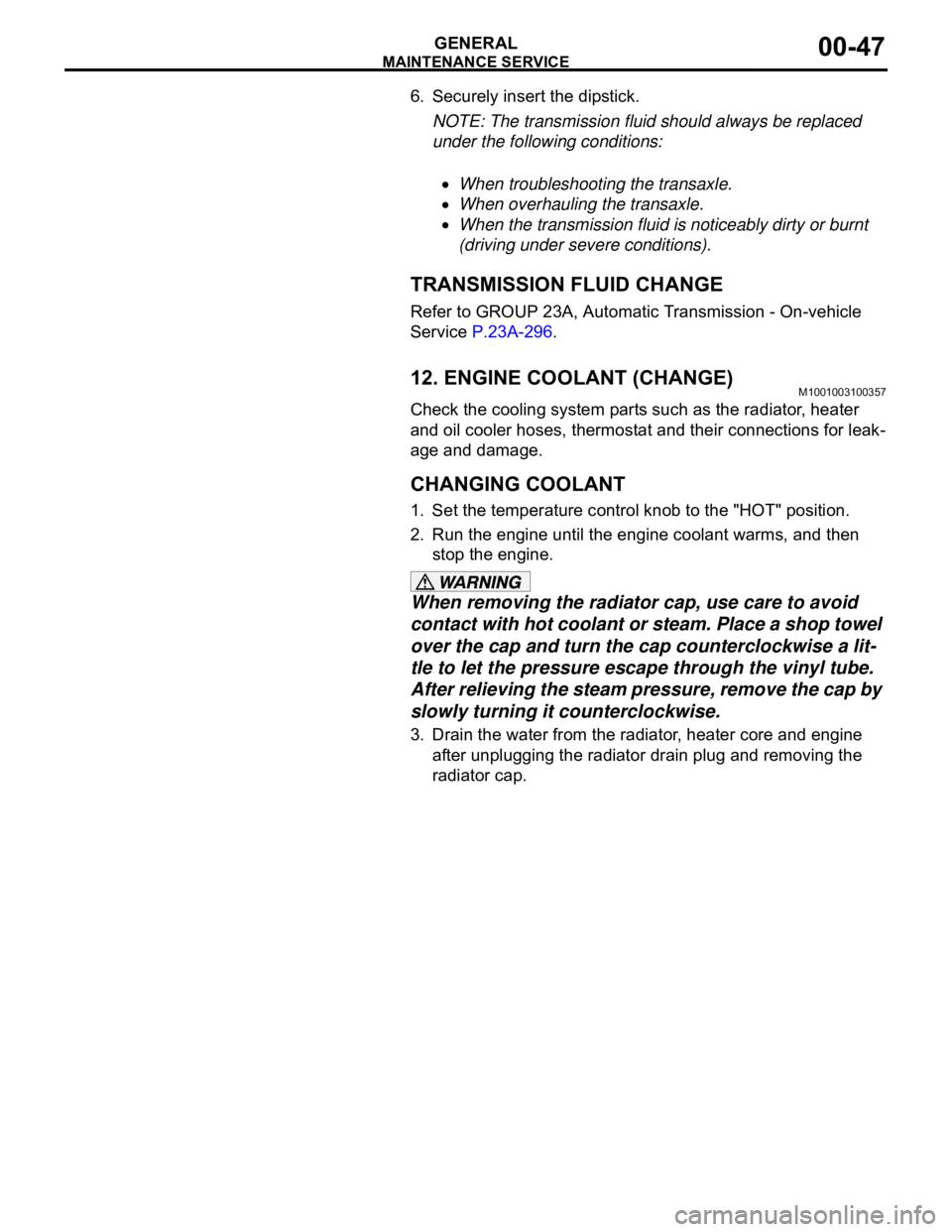Page 1249 of 1500
TOWING AND HOISTING
GENERAL00-28
3. Refrain from going under a vehicle when it is lifted by the
towing equipment, unless the vehicle is adequately sup-
ported by safety stands.
4. Never allow passengers to ride in a towed vehicle.
5. State and local rules and regulations must be followed when
towing a vehicle.
LIFTING, JACKING SUPPORT LOCATION
.
FLOOR JACK
Never place a support at any point other than the speci-
fied one, or that point will be deformed.
For lifting, put rubber or similar material between the
side sill and rigid rack, otherwise the side sill area will
be damaged.
Page 1250 of 1500
TOWING AND HOISTING
GENERAL00-29
.
POST TYPE
Special care should be taken when raising the vehicle on a
frame contact type hoist. The hoist must be equipped with the
proper adapters in order to support the vehicle at the proper
locations.
Page 1251 of 1500
TOWING AND HOISTING
GENERAL00-30
When service procedures require removing rear sus-
pension, fuel tank and spare tyre, place additional
weight on the rear end of vehicle, or anchor vehicle to
hoist to prevent tipping when the location of the center
of gravity changes.
If the lifting support area contacts with the sill cover
(arrow area as shown in the illustration), the sill cover
will be damaged. Ensure that the lifting support does
not contact the sill cover.
Page 1268 of 1500

MAINTENANCE SERVICE
GENERAL00-47
6. Securely insert the dipstick.
NOTE: The transmission fluid should always be replaced
under the following conditions:
.
When troubleshooting the transaxle.
When overhauling the transaxle.
When the transmission fluid is noticeably dirty or burnt
(driving under severe conditions).
TRANSMISSION FLUID CHANGE
Refer to GROUP 23A, Automatic Transmission - On-vehicle
Service P.23A-296.
12. ENGINE COOLANT (CHANGE)M1001003100357
Check the cooling system parts such as the radiator, heater
and oil cooler hoses, thermostat and their connections for leak-
age and damage.
.
CHANGING COOLANT
1. Set the temperature control knob to the "HOT" position.
2. Run the engine until the engine coolant warms, and then
stop the engine.
When removing the radiator cap, use care to avoid
contact with hot coolant or steam. Place a shop towel
over the cap and turn the cap counterclockwise a lit-
tle to let the pressure escape through the vinyl tube.
After relieving the steam pressure, remove the cap by
slowly turning it counterclockwise.
3. Drain the water from the radiator, heater core and engine
after unplugging the radiator drain plug and removing the
radiator cap.
Page 1273 of 1500

MAINTENANCE SERVICE
GENERAL00-52
FRONT IMPACT SENSORS
1. Check that the arrows on the sensors face toward the front
of the vehicle.
The SRS may not activate if a front impact sensor
is not installed properly, which could result in seri-
ous injury or death to the vehicle's driver and pas-
senger.
If a dent, crack, deformation or rust is detected,
replace with a new sensor.
2. Check the front side member and front impact sensor for
deformation or rust.
3. Check the front impact sensor wiring harness for binding;
Check the connector for damage; and check the terminals
for deformation.
Replace the sensor and/or wiring harness if they fail the
visual check (Refer to GROUP 52B, SRS Service
Precautions P.52B-16 and GROUP 52B, Front Impact
Sensor P.52B-231).
SIDE IMPACT SENSORS
If the side impact sensor is not installed securely
and correctly, the side-air bag may not operate
normally.
If a dent, crack, deformation or rust is detected,
replace with a new sensor.
1. Check the side impact sensor and bracket for dents, cracks
or deformation. The side impact sensors are located inside
the center pillars (LH/RH).
2. Check the connector for damage, and terminal for
deformation.
3. Check that there is no bending or corrosion in the center
pillars (LH/RH).
Replace the side impact sensor if it fails the visual check
(Refer to GROUP 52B, Side Impact Sensor P.52B-247).
NOTE: The illustration shows the left side impact sensor (RH).
The position of the other side impact sensor (LH) is symmetri-
cal to this.
Page 1433 of 1500
DRIVE SHAFT ASSEMBLY
FRONT AXLE26-16
<>RH DRIVE SHAFT/DRIVE SHAFT AND
INNER SHAFT ASSEMBLY REMOVAL
1. Use special tools MB990242, MB990244, MB991354 and
MB990767 to push out the drive shaft or the drive shaft and
inner shaft assembly from the hub.
2. Remove the drive shaft from the hub by pulling the bottom of
the brake disc towards you.
Do not pull on the drive shaft; doing so will damage the
PTJ; be sure to use the pry bar.
When pulling the drive shaft out from the transaxle, be
careful that the spline part of the drive shaft does not
damage the oil seal.
3. Insert a pry bar between the transaxle case and the drive
shaft, and then pry and remove the drive shaft from the
transaxle.
NOTE: Insert a pry bar, taking care not to damage the pro-
trusion of transaxle case when removing the drive shaft LH.